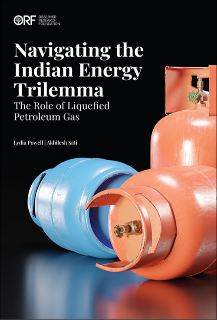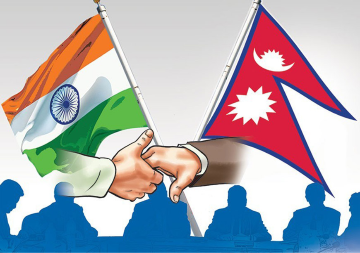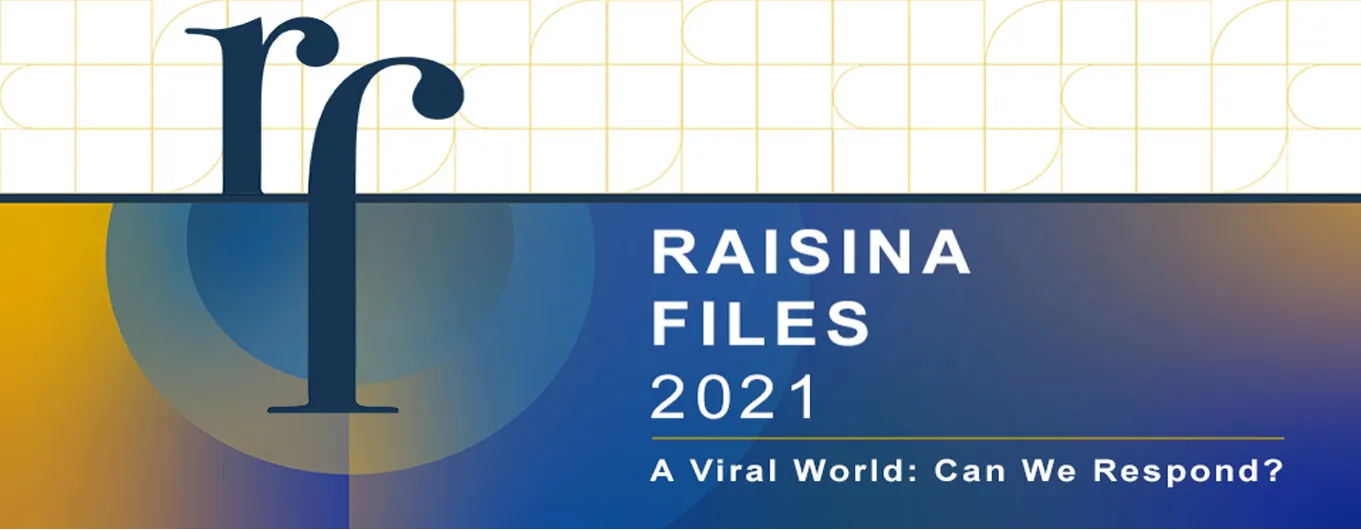
This article is part of the series — Raisina Files 2021.
The COVID-19 pandemic has been a catalyst for the adoption of and reliance on digital technologies, especially internet-based ones. Measures like working and learning online and disseminating information regarding the virus have been executed virtually with varied success. A ‘new normal’ is emerging, one that incorporates using digital technologies in practically every area of contemporary society. It is ushering an age of digital interdependence in which “peaks are yet uncharted and their promise still untold, but the risks of losing our foothold are apparent,” as described in the report of the UN Secretary-General’s High-Level Panel on Digital Cooperation.
There are more than just technical determinants to the successful adoption of digital technologies.
The pandemic has brought into sharp relief the inequalities in access to public goods, such as health and education, worldwide. It has been no different for accessing digital technologies, as they increasingly become a lifeline. It is making evident that the availability of an internet connection, for instance, does not directly translate into the affordability of nor accessibility to that connection. The assumptions, hopes and hype surrounding the advancement of digitalisation have all come up for questioning and, in the process, have showcased that there are more than just technical determinants to the successful adoption of digital technologies.
Digital connectivity biases and development narratives
Digital connectivity narratives mirror development ones. Developed nations are assumed to be well connected, with developing ones lagging. However, the transitions to the virtual domain necessitated by pandemic mitigation measures have exposed the chimera in the availability and affordability of the internet, even across Europe and the US. The ”presumption of the connected” in the US, for example — that broadband reaches everyone, the false equivalency of networks, and that mobile can pick up the slack for fixed broadband — have compounded socioeconomic inequalities, particularly in access to education. Students, particularly from lower-income households, have struggled to adapt to remote learning, owing to insufficient (smartphone-only) connections, unaffordable access to the internet and connecting devices at home, or a lack of them altogether. In the UK, families from poor and vulnerable populations have had to contend with feeding children or paying for Wi-Fi to facilitate online education. Meanwhile, teachers in Italy realised early on in the pandemic that e-learning will only benefit some students, essentially those with ready access to resources such as steady internet connections, computers and tablets, which are not a given in every household.
The dynamics shaping how people engage within their communities and their trust in institutions, especially public ones, is a strong determinant for the successful deployment of any technology.
In public health, the feverish solutionism of contact tracing apps, which were rolled out across developed nations, has been dampened by the reality that it takes more than just connecting the smartphones that are in people’s hands to notify them of potential exposure to the virus. The dynamics shaping how people engage within their communities and their trust in institutions, especially public ones, is a strong determinant for the successful deployment of any technology.
If these digital disparities are prominent across powerful economies, as the past year has exposed, it is a reckoning then, that the ‘digital revolution’ is not a rising tide lifting all boats. Inequalities in how individuals and communities access and use digital technologies exist everywhere and take varied forms. While often discussed as a chasm between the connected and the unconnected, it is increasingly evident that digital divides are prevalent even among the connected.
Illusions of digital access and affordability
The divides in internet connectivity are a useful analytical starting point. While, for instance, approximately 85 percent of the global population is covered by 4G mobile network, this only translates to just over half of the global population being online as of 2019. As the internet increasingly becomes a must-have, ensuring equitable access is a pertinent and complex, if elusive, goal. 5G connectivity — anticipated to cover one-third of the world’s population by 2025 — has generated excitement for its potential to vastly increase internet speeds and enable more connected devices to power Fourth Industrial Revolution phenomena, such as the Internet of Things and Smart Cities. These demand faster device connections to generate real-time data and even predictive insights, such as in traffic management, a potent challenge in many urban areas. This demand and supply of faster generation connectivity (6G is currently under development), while compelling, risks exacerbating and even creating new connectivity divides.
As the internet increasingly becomes a must-have, ensuring equitable access is a pertinent and complex, if elusive, goal.
There is a risk that those who are still unconnected to 3G and 4G connectivity will be further left behind. Network service providers investing in faster connectivity will be more incentivised to focus on areas with existing infrastructure — predominantly urban areas — rather than setting up from scratch, which can be high risk, long-term undertakings that delay returns on investment. In the case of scant or no network coverage, such as in rural areas — 17 percent of rural areas in the least developed countries have no mobile coverage at all — it is unlikely that service providers will leapfrog right to 5G or 6G to connect those who are yet to be served by existing networks. Islands and archipelagos, mountainous and remote areas, and landlocked countries demand steep infrastructure investments, such as international transit capacity, consequently affecting the cost to connect people. In this paradigm, the uncovered could remain off-grid, while those currently covered gain faster coverage, thus widening accessibility divides.
Affordability divides for both the internet and connecting devices are also prone to widen as we migrate to faster connectivity networks. Internet affordability — defined by the UN Broadband Commission as 1GB of mobile broadband costing no more than 2 percent of the average monthly income — remains unattainable for millions, with 1GB costing up to 20 percent of average monthly salary in some countries. Adding to this the cost of internet-enabled phones prices digital connectivity out of reach for many globally, even in developed nations.
Affordability divides for both the internet and connecting devices are also prone to widen as we migrate to faster connectivity networks.
Nor does having access to an internet connection equate to having a meaningful online experience. Mobile connectivity is a convenient yardstick for assessing internet coverage and reach. Nonetheless, mobile-only internet connectivity can be limiting, particularly in an increasingly digitised world of work and learning. The mobile phone is an effective tool for consumption but quite limiting for creation. One, for instance, will be vastly limited in learning or writing code purely through a smartphone; they will likely require access to a computer device, yet another cost factor in connecting. Therein lies a subtle divide, between mobile phone-only versus mobile and computer-enabled internet access, one that is prone to disfavour those with lower and fewer income opportunities.
Disparate entry points into the digital world do not necessarily converge towards equity once people are connected. A distinguishing success factor for maximising digitalisation’s potential is the existing digital skills of individuals and communities. This is strongly linked to educational opportunities; schools serve as important nodes for cultivating technical and critical skills to be a consumer and a prospective creator and contributor in digital economies. Formal education already contains glaring inequalities in availability, access and quality, further exacerbated by the disruptions brought on by the pandemic. Approximately 1.5 billion students in primary, secondary and tertiary education worldwide have been affected by school closures owing to the COVID-19 pandemic. In many communities, schools are a crucial — and even the only — avenue through which learners can be exposed to computers, the internet and skills-training opportunities. Enjoying the benefits of e-learning, edtech and other digitalisations of education is contingent on the availability and access to such opportunities, at home or within the community, which is far from the case in many parts of the world. Skills divide exist in varied forms, presenting yet another hurdle to digital equality. Over time, they are also generating gaps between digital producers and consumers, an issue that warrants special attention. Furthermore, a language divide is crystallising as more and more people get digitally connected. It has been estimated that 95 percent of languages will never gain traction online. English is and has been the ‘lingua franca’ of the internet, even as other languages gain ground at the content level. However, if you do not speak English, you are likely to be disadvantaged, as it still holds sway in areas such as coding.
Skills divide exist in varied forms, presenting yet another hurdle to digital equality. Furthermore, a language divide is crystallising as more and more people get digitally connected.
These are glaring examples of ‘legacy inequalities’ (such as income) appearing alongside emergent ones brought about by the march towards digitising. Understanding digital (in)equality then requires a continuous inquiry to unearth these nuances and expand upon them. Income, for instance, is also a function of sociocultural norms. Women earn less or are not ‘allowed’ to earn an income and are denied education opportunities in many communities, which means that they are even more exposed to access, affordability and skills divides, compounding these digital dynamics to create digital gender divides.
Chimaeras after access
The internet was once envisioned as an equaliser — a space in which once one gains access and can navigate and create freely. Today, it is predominantly encountered and experienced as a series of platforms, especially for new users. Social media platforms have been instrumental in connecting and community-building as people from different walks of life transcend physical borders and congregate online, exploring shared and disparate interests. In many countries, social media applications can constitute the entirety of people’s internet experience. Popular applications are often zero-rated against one’s mobile internet subscription by their network provider, making them accessible at no additional cost. Having to pay then to access the vastness of the digital world beyond a selection of these applications can be a disincentive in this configuration.
In the name of improving user experience, the resultant tinkering ends up getting and keeping people hooked; algorithmic curation and data-driven experimentations are employed to fuel online consumption and expenditure.
Meanwhile, the companies behind these tools have grown into behemoths, commanding the attention of billions of people. They have identified monetisation opportunities that, over time, have made a selection of them some of the wealthiest and most influential companies in the world. In the name of improving user experience, the resultant tinkering ends up getting and keeping people hooked; algorithmic curation and data-driven experimentations are employed to fuel online consumption and expenditure. To capitalise on these discoveries, social media platforms have created enclosures — moving away from the open, decentralised web from which they benefited, to establish ‘walled gardens’ designed to lock in the users they attract. They have expanded from mere communication and connection channels to public utilities offering a suite of services to other institutions such as media and civic groups, thus bringing more and more of the world to the users addicted to their glitzy digital empires.
Over time, the sorting and targeting of users to present specific information at specific times — available to any actor with purchasing power to reach predetermined groups within these apps — has aggravated information divides, severely jeopardising what constitutes shared facts across societies. For the half of the global population that is online, our “epistemic wellbeing” is under threat, as our access to truths, to trustworthy information sources and to avenues for participating in dialogue are poisoned by the evolution of internet platformisation that is optimised to draw and retain us in informational filter bubbles. Online civic life across developing and developed countries has been adversely affected, with serious consequences to the offline world. The pandemic has further highlighted the gravity of this crisis, leading the World Health Organization to declare a parallel “infodemic” as falsehoods and knowledge distortions about COVID-19 have spread at an unprecedented rate primarily through these online spaces.
For the half of the global population that is online, our “epistemic wellbeing” is under threat.
Where are we headed?
Information and communications technologies have presented numerous benefits, of which social media are one notable example. As is now evident, there are also severe downsides and outright dangers. In policymaking circles, the spotlight on digital technologies has narrowly focused on the advantages and promises that digitalisation offers. Giddy public and private sector driven investments have been made to chase digital utopia illusions, not sufficiently factoring in that it takes more than just developing and deploying technology to fix any range of challenges. The pandemic has been an important inflexion point, bringing to bear the pitfalls societies have found themselves in and the role that technologies can (not) play.
For those who will successfully graduate to the future generations of connectivity, intense trade-offs abound. 5G, for instance, demands higher connection density; cellular towers have to be mounted much closer together to reduce latency and increase connecting speeds. This means that it will be much easier to track and pin down users’ location via their mobile networks. Urban residents will exist in hyper-connected built environments and private domains laden with monitoring devices, given the rise of internet-enabled home devices and the trendiness of smart wearable devices. As a result, they will be susceptible to loss of privacy.
The pandemic has been an important inflexion point, bringing to bear the pitfalls societies have found themselves in and the role that technologies can (not) play.
Meanwhile, those who remain unconnected are being further left behind, with inequalities online and offline widening as access to essential goods and services become more technology-dependent. Their privacy, in the interim, may yet remain intact, though it will be the odd outcome of digital exclusion. As and when any generation of technologies reach them, they will intersect with other inequalities, such as in access to education and health services. Such systematic disenfranchisement will significantly compromise the agency that such communities can exercise in determining the technological investments appropriate for their context. Such ‘coerced connectivity’ will subject such communities to perverse, extractive technological experiences. Whether connected or unconnected, the future of digitalisation does not necessarily bode as well for humanity as technology evangelists would have us believe.
The issues we face in this decade are complex and interconnected. Digitalisation, it turns out, is mirroring the social inequalities and grievances present across societies, and in many instances, it is aggravating them. This is unfolding in developing and developed nations alike. As we become more reliant on these tools that are being developed, designed and deployed at a dizzying pace, tech companies are gaining new ground in virtually all spheres of life. They are venturing into health, education, agriculture, labour and commerce, to name a few. The rules and regulations to keep this rapid innovation and sectoral encroachment in check are lagging behind and even frowned upon; it is common to hear the refrain that ‘regulation punishes innovation.’ Yet, as existing and emerging technologies are fashioned in the image of their creators and their inherent biases, they are clashing with diverse social contexts. Given the power accumulating in shaping how digitalisation rolls out, there is an accompanying imposition and encoding of an unrepresentative sample of realities into political, civic, social, cultural and economic domains. Without cross-disciplinary and intersectional policy, legislative and regulatory guardrails, these behemoths are bound to further pursue profit-maximising practices that, while registering digital progress, will be at the expense of social cohesion.
Whether connected or unconnected, the future of digitalisation does not necessarily bode as well for humanity as technology evangelists would have us believe.
The digital disparities surfaced by the COVID-19 pandemic should give us pause. It is time to acknowledge and account for and urgently start correcting digital illusions and biases and their antecedents and emergent ones that did not exist before digitalisation. Shaping global governance for the digital age cannot afford to ignore these chimaeras. There are no quick fixes, and they are not solely technological. Improving access to digital technologies is interconnected with improving access to education and infrastructure, such as reliable energy. It is dependent on closing income and gender inequalities. It also calls for accommodating diverse lived experiences, especially those of the already excluded and vulnerable populations across every country. The global goals for sustainable development will remain ever more elusive if we do not vigorously undertake a sober intellectual and moral exercise to galvanise the collective efforts across public, private and civil society sectors to maximise digital technologies’ benefits while minimising risks and harms.
UN Secretary General’s High-Level Panel on Digital Cooperation, The Age of Digital Interdependence, United Nations, 2019.
Christopher Ali, “The Presumption of the Connected,” Benton Institute for Broadband & Society, 24 March 2020.
Alec MacGillis, “The Students Left Behind by Remote Learning,” Propublica, 28 September 2020.
Emmanuel Martinez, “How Many Americans Lack High-Speed Internet?” The Markup, 26 March 2020.
Hannah Holmes and Gemma Burgess, “"Pay the wi-fi or feed the children”: Coronavirus has intensified the UK’s digital divide,” University of Cambridge.
Lizzie Winter, “I’m a teacher in Italian quarantine, and e-learning is no substitute for the real thing,” The Guardian, 18 March 2020.
Chas Kissick, Elliot Setzer and Jacob Schulz, “What Ever Happened to Digital Contract Tracing?” Lawfare, 21 July 2020.
Susan Landau, “Contract-Tracing Apps: What’s Needed to Be an Effective Public Health Tool,” Lawfare, 19 January 2021. .
International Telecommunications Union, Measuring digital development: Facts and figures 2020, ITU, 2020.
International Telecommunications Union, Measuring digital development: Facts and figures 2019, ITU, 2019.
GSMA, “5G Global Launches & Statistics,” GSMA.
“Measuring digital development: Facts and figures 2020”
Alliance for Affordable Internet, Affordability Report 2018, Alliance for Affordable Internet, 2018.
Broadband Commission for Sustainable Development, 2025 Targets: “Connecting the Other Half,” ITU and UNESCO, 2018.
Alliance for Affordable Internet, Affordability Report 2019, Alliance for Affordable Internet, 2019.
Linda Poon, “Could You Live Entirely on Mobile Internet? Try It for a Day,” Bloomberg, 17 January 2018.
UNESCO, “Global Education Coalition,” UNESCO, 2020.
Holly Young, “The digital language divide,” The Guardian, 2017.
Gretchen McCullotch, “Coding Is For Everyone—as Long as You Speak English,” Wired, 8 April 2018.
Laura Robinson et al., “Digital inequalities 2.0: Legacy inequalities in the information age,” First Monday, 25(7) (2020).
Alliance for Affordable Internet, Affordability Report 2015-16, Alliance for Affordable Internet, 2016.
Leo Mirani, “Millions of Facebook users have no idea they’re using the internet,” Quartz, 9 February 2015.
Kenneth Boyd, “The antidote to fake news is to nourish our epistemic wellbeing,” Psyche, 27 January 2021.
“Call for Action: Managing the Infodemic,” WHO, 11 December 2020.
Michael Grothaus, “5G means you’ll have to say goodbye to your location privacy,” Fast Company, 1 March 2019.
The views expressed above belong to the author(s). ORF research and analyses now available on Telegram! Click here to access our curated content — blogs, longforms and interviews.




 PREV
PREV



